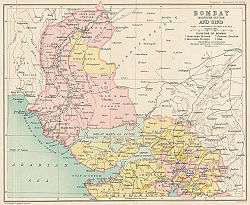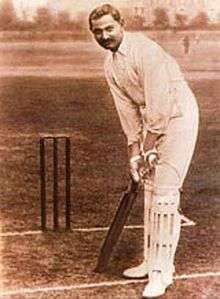Nawanagar State
| Nawanagar State નવાનગર રિયાસત नवानगर रियासत | ||||||
| Princely State of British India | ||||||
| ||||||
| ||||||
 | ||||||
| History | ||||||
| • | Established | 1540 | ||||
| • | Independence of India | 1948 | ||||
| Area | 9,632 km2 (3,719 sq mi) | |||||
| Today part of | Gujarat state of India | |||||
| Nawanagar (Princely State) | ||||||

Nawanagar was an Indian princely state in the historical Halar region of Kathiawar, located on the southern shores of the Gulf of Kutch. It was ruled by the Jadeja dynasty from its formation in c 1540 until 1948 when it became a part of newly formed India. The district is now known as Jamnagar. It had an area of 3,791 square miles (9,820 km2) and a population estimated at 336,779 in 1901. Its rulers, who used the title of "Jam Saheb" were Hindu Rajput of the same clan as the Rao of Cutch. They were entitled to a 13-gun salute. The state flag was a rectangular red flag with a white elephant, near and facing the hoist. During the British Raj, the state was part of the Kathiawar Agency, within the Gujarat Division of Bombay Presidency.[1]
The state had a pearl fishery and much of its wealth came from this. Nawanagar is also famous for its former ruler Jam Saheb Ranjitsinhji (died 1933), who was a famous cricket player at Cambridge in England before his accession to the throne.
History
Nawanagar was founded in 1540 by Jam Rawalji, a descendant of the Jadeja ruler of Kutch, and was thereafter in an almost constant state of war with its neighbours and with the Mughal Empire. One of such major was the Battle of Bhuchar Mori fought in 1591. The "Walker Treaty of 1807" brought peace to the Kathiawar states for the first time in several generations. Nawanagar came under British protection on February 22, 1812.
K. S. Ranjitsinhji was one of the world’s greatest cricket players and, later, became Jam Saheb in 1907 until 1933.[2] The inclusive circle of eight players promoted excellence in cricket,both in the county and domestic games. After his death, Ranji Trophy, a domestic first-class cricket championship played in India between different city and state sides, was started in 1934 by Board of Control for Cricket in India (BCCI).
Ranjitsinhji remained the Chancellor of the Chamber of Princes (1931–1933). After his death, in 1933, he was succeeded by his nephew K. S. Digvijaysinhji, who became its Chancellor (1937–1944) and continued to promote the octet circle in excellence in cricket, academics and welfare.
Nawanagar was one of the first princely states to sign the Instrument of Accession in 1948 after Indian independence. Afterwards, the former ruler, Digvijaysinhji, served as the first Rajpramukh of Kathiawar, then represented his country at the United Nations.
In 1949, the former princely states of Nawanagar and Dhrol, Jalia Dewani in Kathiawar merged into the new state of Saurashtra. On June 19, 1959, the boundaries of the district were enlarged by the inclusion of the adjoining Okhamandal, and the district was renamed Jamnagar. This district became part of the new State of Gujarat on the division of the State of Bombay on May 1, 1960.[3]
Jam Saheb
| Regime | Rulers | Born | Died |
|---|---|---|---|
| October 2, 1690 - October 13, 1708 | Lakhaji Tamachi | 1708 | |
| October 13, 1708 - August 13, 1711 | Raisinhji Lakhaji | 1711 | |
| August 13, 1711 – 1743 | Tamachi Raisinhji | 1743 | |
| September 1743 - November 2, 1767 | Lakhaji Tamachi | 1743 | 1767 |
| November 2, 1767 - August 6, 1814 | Jasaji Lakhaji | 1814 | |
| August 6, 1814 - February 24, 1820 | Sataji ll Lakhaji | 1820 | |
| February 24, 1820 - February 22, 1852 | Ranmalji Sataji ll | 1852 | |
| February 22, 1852 - April 28, 1895 | Vibhaji II Ranmalji | 1827 | 1895 |
| April 28, 1895 - August 14, 1906 | Jashwantsinhji Vibhaji II | 1882 | 1906 |
| March 12, 1907 - April 2, 1933 | Ranjitsinhji Vibhaji II | 1872 | 1933 |
| April 2, 1933 - August 15, 1947 | Digvijaysinhji Ranjitsinhji | 1895 | 1966 |
| February 3, 1966 - December 28, 1971 | Shatrushalyasinhji Digvijaysinhji | 1938 | living |
Jewellery collection
The Maharaja Jamsahib of Nawanagar were also known for their Jewellery collection; especially Ranjithsinhji, whose Emerald collection according to Jacques Cartier was "unequaled in the world, if not it quantity, then certainly in quality". The collection included an emerald and pearl necklace, an art deco emerald and diamond necklace designed by Jacques Cartier, and an Emerald collar or choker also designed by Jacques Cartier.[4][5]
The 61.50 carat (12.3 g) whiskey-coloured diamond, "The Eye of the Tiger", was mounted by Cartier in a turban aigrette for the JMaharaja or Maharaja of Nawanagar in 1934.[6]
See also
References
- ↑ "Nawanagar State". The Imperial Gazetteer of India, v. 18. Oxford Clarendon Press, London. 1909. p. 419.
- ↑ "Sir Ranjitsinhji Vibhaji, Maharaja Jam Saheb of Nawānagar". Britannica.com.
- ↑ Nawanagar
 This article incorporates text from a publication now in the public domain: Chisholm, Hugh, ed. (1911). "article name needed". Encyclopædia Britannica (11th ed.). Cambridge University Press.
This article incorporates text from a publication now in the public domain: Chisholm, Hugh, ed. (1911). "article name needed". Encyclopædia Britannica (11th ed.). Cambridge University Press. - ↑ "Emerald Necklaces of the Maharajah of Nawanagar".
- ↑ Nadelhoffer, Hans (2007). Cartier. Chronicle Books. p. 169. ISBN 0-8118-6099-X.
- ↑ Eye of the Tiger
External links
 Media related to Nawanagar State at Wikimedia Commons
Media related to Nawanagar State at Wikimedia Commons- Nawanagar, website
- Heraldry of princely states of Gujarat
Coordinates: 22°28′N 70°04′E / 22.47°N 70.07°E

